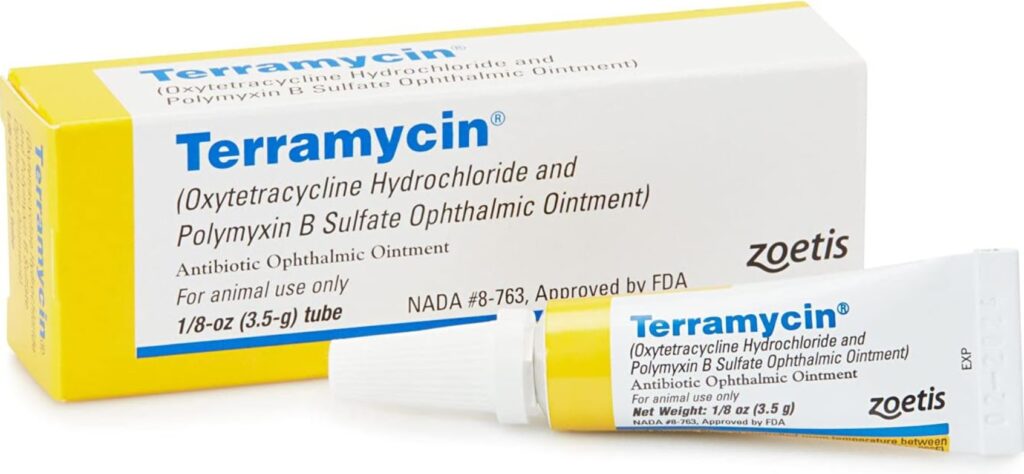We all know that familiar pang of worry when we spot something amiss with our furry friends – be it a limp, a cough, or those watery eyes that hint at an infection. Eye infections, particularly, can sneak up on our canine companions and leave us feeling helpless, especially if we’re not sure how to treat them at home. With a myriad of information online, and numerous products claiming to be the ultimate solution, finding the right ointment for a dog eye infection can be a tad overwhelming.
That’s where this guide comes in. After extensive consultations with vets and personal experiences with my own four-legged buddy, I’ve come to rely on one over-the-counter ointment: Terramycin. In this blog, we’ll dive deep into what makes Terramycin a trusted choice, its ingredients, and how it stands up against other home remedies. Plus, for those who lean towards more natural treatments, I’ve got you covered with some alternative homeopathic options.
So, if you’re scrambling to find an effective solution to your dog’s eye infection, or simply prepping for potential future flare-ups, you’re in the right place. Let’s ensure our dogs get the care they deserve, right from the comfort of our homes!

What is Terramycin?
Terramycin, often regarded as a wonder drug in the world of veterinary medicine, isn’t a new name for many seasoned pet owners. But if you’re unfamiliar, allow me to introduce you to this versatile ointment.
Historical Context and Discovery:
Terramycin, scientifically known as oxytetracycline, was first introduced to the world in the 1950s by Pfizer. It heralded a new era in antibiotic research, becoming one of the first broad-spectrum antibiotics. This meant it could combat a wide variety of bacterial infections, making it a staple in many medical and veterinary toolkits.
Popularity and Trusted Recommendation by Vets:
Over the decades, Terramycin has earned its reputation not just by effectively treating infections but also due to its safety profile. Veterinarians around the globe often recommend it for its efficacy against a wide range of bacterial eye infections in animals. It’s not uncommon to find Terramycin in the medicine cabinets of breeders, farmers, and everyday pet parents like you and me.
The true magic of Terramycin lies in its mechanism of action. It inhibits protein synthesis in bacteria, preventing them from growing and multiplying. This gives the body’s immune system a chance to catch up and clear out the invaders, restoring your dog’s eyes to their clear, vibrant state.
In essence, Terramycin is more than just an ointment; it’s peace of mind in a tube, ensuring our beloved dogs get relief from discomfort and a speedy recovery from eye infections.

What Does Terramycin Treat?
When it comes to the health of our furry friends, particularly their eyes, we all yearn for a solution that’s both broad in its efficacy and specific in its action. Terramycin, with its rich history and trusted reputation, fits that bill perfectly. So, what exactly does this wonder ointment treat? Let’s dive in.
1. Bacterial Conjunctivitis:
Commonly known as “pink eye,” bacterial conjunctivitis can cause redness, swelling, and discharge in your dog’s eyes. It’s one of the most frequent eye ailments in canines. Terramycin helps by targeting the bacteria responsible, clearing up the infection, and reducing the associated discomfort.
2. Keratitis:
This is an inflammation of the cornea which can be caused by several bacteria. Left untreated, it can lead to more severe complications. Thankfully, Terramycin is effective against many of the bacterial culprits behind keratitis.
3. Blepharitis:
An inflammation of the eyelids, blepharitis can make your dog’s eyes appear crusty and can be quite painful. Terramycin helps soothe the inflammation and tackle the underlying bacterial cause.
4. Corneal Ulcer:
While corneal ulcers have several causes, when they are the result of a bacterial infection, Terramycin can be a lifesaver. It aids in healing the ulcer by eliminating harmful bacteria and preventing secondary infections.
5. Prevention:
Apart from treating active infections, Terramycin is also used as a preventive measure. If your dog has recently had eye surgery or an injury, Terramycin can help ward off potential bacterial infections.
In summary, Terramycin’s broad-spectrum nature makes it a go-to for numerous bacterial eye infections in dogs. However, always remember, while it’s an excellent tool in the arsenal against bacterial infections, it won’t be effective against fungal or viral infections. If you’re ever in doubt about the nature of your dog’s eye condition or the best course of treatment, always consult with a veterinarian.

Ingredients in Terramycin
Understanding what goes into our pets’ treatments is vital. It’s not just about ensuring safety but also about appreciating how the product works. Let’s peel back the label on that tube of Terramycin and delve into its ingredients.
1. Active Ingredient: Oxytetracycline Hydrochloride
The star of the show, oxytetracycline hydrochloride, belongs to the tetracycline class of antibiotics. As we’ve discussed earlier, its primary role is to inhibit bacterial protein synthesis, thus stopping the bacteria from multiplying and allowing the body’s immune system to destroy them. Oxytetracycline is broad-spectrum, which means it’s effective against a variety of bacteria.
2. Active Ingredient: Polymyxin B Sulfate
This is another potent antibiotic compound found in Terramycin. Polymyxin B specifically targets gram-negative bacteria, complementing the action of oxytetracycline. Together, these two ensure a wide range of bacteria are addressed, making the ointment highly versatile.
3. Inert Ingredients:
While the specific composition might vary slightly based on the manufacturer, Terramycin typically contains ingredients to ensure the ointment remains stable, easy to apply, and safe for use in the eyes. These may include:
- Petrolatum: Acts as a base, helping the ointment stay in place once applied and ensuring prolonged contact with the eye.
- Lanolin: A natural moisturizer that helps soothe the eye and keep it lubricated, providing additional comfort to your pet.
- Mineral Oil: Aids in the smooth application and can assist in keeping the eye moisturized.
Safety and Allergens:
While Terramycin is generally safe for most dogs, it’s essential to be aware of its ingredients in case your pet has specific allergies. Always monitor for any adverse reactions when first applying the ointment and consult your vet if you’re uncertain.
In essence, the ingredients in Terramycin work harmoniously to combat bacterial infections. The active components tackle the bacteria, while the inert ingredients ensure the ointment is comfortable, safe, and easy to apply.
How to Apply Terramycin on Your Dog’s Eye
How to Apply Terramycin on Your Dog’s Eye
Administering any medication to our pets can sometimes feel like a daunting task. The eyes, being such a sensitive area, require gentle care and precision. To help you out, here’s a step-by-step guide on applying Terramycin ointment to your dog’s eyes safely and effectively.
1. Preparation:
- Clean Hands: Start by washing your hands thoroughly with soap and water. Ensure they’re clean to prevent introducing any additional bacteria to your dog’s eye.
- Clean the Eye: If your dog’s eye has discharge or crustiness, gently clean the area with a soft, damp cloth or a sterile saline solution. Remember to pat dry with a clean towel.
2. Get Your Dog Comfortable:
- If your dog is skittish or unfamiliar with eye treatments, it might be helpful to have a second person assist. One can hold and soothe the dog, while the other administers the ointment.
- You can also place your dog on a table or hold smaller breeds in your lap, wrapping them gently in a towel to keep them still.
3. Application:
- Hold the tube of Terramycin using your thumb and forefinger.
- Gently pull down your dog’s lower eyelid using your free hand to create a small pocket for the ointment.
- Squeeze a small amount (typically about 1/4 inch) of the ointment directly into the pocket. Avoid touching the tube’s tip to the eye or any surface to prevent contamination.
- Release the eyelid and let your dog blink, spreading the ointment across the eye.

4. Post-Application:
- Offer your dog a treat or some gentle praise for staying still. This positive reinforcement can make future applications easier.
- Recap the Terramycin tube tightly and store it in a cool, dry place.
- Wash your hands again after the application.
5. Frequency and Duration:
While it’s always best to follow your vet’s instructions, the general recommendation for Terramycin is to apply it 2-4 times daily. The duration will depend on the severity of the infection and how quickly your dog responds to the treatment. Typically, it’s advised to continue treatment for 48 hours after symptoms have subsided to ensure the infection is fully addressed.
6. Tips and Precautions:
- Always monitor your dog after application to ensure they don’t rub their eyes, which might remove the ointment.
- If your dog shows any signs of an allergic reaction or the condition worsens, stop the treatment and consult your veterinarian immediately.
- Avoid using the ointment past its expiration date.
By following these steps and being gentle and patient, applying Terramycin to your dog’s eyes should be a breeze. Remember, consistency is key to a quick recovery!
Alternative Home Remedies for Dog Eye Infections
While Terramycin is a reliable and effective solution for many bacterial eye infections, some pet owners seek alternative or complementary treatments, especially from the natural world. Let’s explore some of these home remedies that can help soothe your dog’s eye discomfort.
1. Homeopathic Drops:
- Overview: Homeopathic eye drops, often made from natural herbs and minerals, aim to alleviate symptoms without introducing strong chemicals.
- Where to Find: These drops can be sourced from specialty pharmacies or natural food stores. Always ensure that any product you choose is safe for pets.
- Usage: Follow the instructions on the label or as prescribed by your vet. Generally, these drops can be administered 2-3 times daily.
2. Chamomile Tea:
- Overview: Chamomile is renowned for its soothing and anti-inflammatory properties. When used as a rinse, it can help reduce irritation and redness.
- Preparation: Brew a cup of chamomile tea and let it cool down to room temperature. Use a tea bag for convenience, ensuring there are no added flavors or preservatives.
- Usage: Soak a clean cloth in the cooled tea and gently wipe your dog’s eye. Alternatively, you can use a dropper to apply a few drops of the tea to the infected eye.
3. Saline Solution:
- Overview: A simple saline solution can help clean the eye and remove debris or discharge. It mimics the natural tears and can be soothing for inflamed eyes.
- Preparation: Mix a teaspoon of salt in a cup of boiled, then cooled water. Stir until the salt dissolves completely.
- Usage: Dip a clean cloth or cotton ball into the solution and gently clean your dog’s eye. You can also use a dropper to apply it directly.
4. Goldeneye/Rod Tea Treatment:
- Overview: Not as commonly known as chamomile, goldeneye (or goldenrod) has properties that can benefit eye health.
- Preparation: Similar to chamomile, steep the goldeneye/rod in hot water, then allow it to cool to room temperature.
- Usage: Use a clean cloth to apply the tea to the dog’s eye or use a dropper for direct application.
Precautions and Recommendations:
- Always test a small amount of any remedy to check for adverse reactions before full application.
- While these remedies can be soothing, they might not replace the need for antibiotics in severe bacterial infections. It’s always best to consult with your vet before starting or switching treatments.
- Ensure that any product or ingredient you’re using is safe for pets. Some natural remedies suitable for humans might not be safe for dogs.
Whether you’re leaning towards a more natural approach or looking for complementary treatments to work alongside antibiotics, these remedies can offer some relief. However, always prioritize the advice of your veterinarian.

Potential Risks and Side Effects
Any form of medication, whether prescribed or over-the-counter, can present risks and side effects. When it comes to our furry friends, we must be informed and vigilant. Let’s delve into the potential risks and side effects associated with eye treatments like Terramycin and other remedies.
1. Terramycin (Oxytetracycline and Polymyxin B):
- Allergic Reactions: Some dogs might develop an allergic response to one of the ingredients in the ointment. Signs include increased redness, swelling, itchiness, or rashes around the eyes.
- Irritation: There may be a stinging or burning sensation upon initial application. If this persists or seems severe, it’s essential to consult with your vet.
- Secondary Infections: On rare occasions, prolonged use can lead to fungal infections in the eye.
2. Homeopathic Drops:
- Ineffectiveness: While they can be soothing, homeopathic treatments may not always address the root cause of the infection.
- Allergic Reactions: As with any medication, there’s a potential for an allergic response. Always monitor closely after the first application.
3. Herbal Teas (like Chamomile and Goldeneye/Rod):
- Potential Irritants: Not all dogs will react the same way to herbal treatments. Some might find certain herbs irritating.
- Contamination Risk: If the tea isn’t prepared with clean, boiled water or if the herbs aren’t sourced from reputable providers, there’s a risk of introducing contaminants.
4. Saline Solution:
- Salt Concentration: If the saline solution is too salty, it can cause discomfort or dryness. Always ensure a mild concentration.
General Tips and Precautions:
- Monitor After Application: After applying any treatment, keep an eye on your dog for the next few hours to notice any adverse reactions.
- Avoid Mixing Treatments: Unless advised by a vet, avoid using multiple treatments simultaneously as this can lead to interactions or increased irritation.
- Consultation: If in doubt, always reach out to your veterinarian. They can provide guidance tailored to your dog’s specific needs and conditions.
- Consistency in Observation: Even if the initial applications don’t cause any side effects, it’s essential to be consistently observant. Side effects can manifest after several applications.
- Storage: Ensure all treatments are stored appropriately, away from heat and direct sunlight, and out of reach of children and pets.
In summary, while treatments like Terramycin and home remedies can offer relief and healing, being aware of the potential risks helps ensure the safety and well-being of our beloved pets. Always prioritize their comfort and health, and when in doubt, seek professional advice.

Conclusion
Our canine companions bring boundless joy, unwavering loyalty, and heartwarming moments into our lives. In return, they rely on us to ensure their well-being and health. When it comes to issues like eye infections, the wealth of information and treatment options available can be overwhelming. However, armed with the right knowledge and guidance, addressing such concerns becomes a smoother journey.
From the tried-and-tested effectiveness of Terramycin to the soothing touch of natural remedies, there are various paths to ensuring your dog’s eye health. As we’ve highlighted throughout this guide, the key is always to prioritize safety, be observant, and maintain open communication with your veterinarian.
Every dog is unique, and what works for one might not necessarily be the best fit for another. But with patience, care, and the insights we’ve shared, you can navigate the realm of canine eye care with greater confidence and peace of mind.
Thank you for joining us on this deep dive into treating dog eye infections at home. We hope you’ve found this guide informative and helpful. Always remember: the sparkle in your dog’s eyes is a reflection of the love and care they receive. Here’s to many more years of that beautiful, healthy sparkle!
